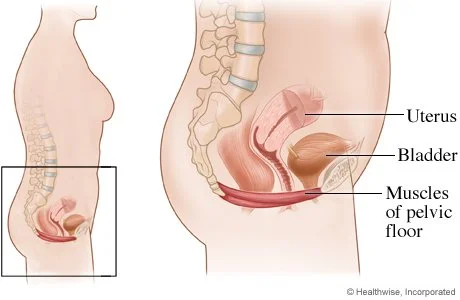You do WHAT for a job?!
Whenever I tell someone that I am a physical therapist, the next question I often get is if I specialize in anything. When I tell them that I treat the pelvic floor, I usually get a blank stare and a couple of follow-up questions.
What is a pelvic floor? How on earth do you do therapy on that?
My hope for this initial blog is to help spread the word about the pelvic floor and if pelvic floor PT might be right for you.
What is my pelvic floor?
Your pelvic floor is a collection of muscles at the base of your pelvis. Don't worry, I won't bore you with the names of each specific muscle and where they attach within the pelvis. Even though I find it fascinating, I realize that the rest of the world, does not. As a whole, the pelvic floor serves many purposes, including:
Supporting your internal organs
Allowing urine, feces, and gas to exit at appropriate times
Sexual function
Stabilizing your pelvis and low back, and connecting your legs to your trunk
Helping pump blood and other fluids out of your pelvis
pelvic floor
Even though the picture above is of a female (see the uterus), the pelvic floor muscles for males and females are quite similar and serve the same basic function.Often times, we take for granted that our pelvic floor will continue to function properly. However, life is messy, accidents happen, and we are often hard on our bodies. Many things can weaken or damage our pelvic floor...
Pregnancy and childbirth (especially with vaginal tearing or instrument-assisted delivery)
Obesity
Chronic straining
Chronic constipation
Improper heavy lifting at the gym, your children, at work
Frequent/heavy coughing
Age (muscles naturally weaken and connective tissue starts to slack)
High impact activities, such as long-distance running, repetitive jumping, etc
Sexual trauma
Once the pelvic floor no longer functions like it should, it can lead to many deficits (or issues). These include:
Urinary and/or fecal incontinence (aka leaking pee and poop)
Pelvic pain (can be felt in the pelvis, lower abdomen, vagina, penis, or rectum)
Pelvic Organ Prolapse (bulging at the vagina or rectum)
Urinary hesitancy (difficulty starting or maintaining a stream or urine)
Pain during intercourse, inability to insert tampons, or inability to tolerate pelvic exams
Constipation
Coccyx/Tailbone pain
Many of the above items are common, but that does NOT make them normal. That is where I (or other pelvic health PT's) come in. You do not need a referral to see a physical therapist in Missouri anymore (legally). However, your insurance may require one, so you should check that out. At Mid-Missouri Pelvic Health, I am not in network with any insurances, so we don’t have to worry about that. I would LOVE to work with you if you live in the mid-Missouri area! Visit the "Book Now" tab to schedule your appointment today. You can also check out this website to search for a pelvic rehab practitioner in your area.
How do you do therapy on that?
Treatment of the above issues requires additional training beyond PT school. At the very least, your therapist should have completed a clinical rotation or attended extra coursework to become competent in these areas. Every therapist does his/her evaluations differently, especially depending on why you are coming.I realize that this area of the body is very sensitive and personal, both physically and emotionally. I encourage you to bring a friend or family member to be present if it makes you more comfortable. Below is a VERY ROUGH draft of what you can expect on your first visit within a private treatment room. At your evaluation you will get...
A LOT of questions. The interview is the time when the therapist gets to know you and what issues you're having. It's also your turn to ask questions and take control of the issues from which you are suffering. Questions could include...
how long you have had your symptoms
how would you describe them
any pertinent history (pregnancies, childbirth history, gynecological or abdominal surgeries, history of trauma to the pelvis)
other medical conditions you have
Do NOT be embarrassed by any symptoms you are experiencing. Trust me, I have heard a lot. Chances are, if you are experiencing it, someone else is too, they're just not talking about it.
A quick look at your back, hips, and abdominal muscles, including how they move
An external examination (looking at the skin of the external genitalia - any scar tissue, redness, irritation, wounds)
The #1 question I get during the evaluation is
"Do I look NORMAL down there?"
I plan on doing another blog about the huge variation in appearance of external genitalia. Don't worry, it won't be vulgar.
And lastly, internal examination (either vaginally or rectally) -- ONLY if you are okay with it! -- Includes a single, gloved digit/finger examination looking at...
tolerance to examination (are the entry muscles so tight and mad that they've blocked anything from entering)
strength, coordination, and endurance of pelvic floor muscles
any tenderness in the deeper muscles
Based on the findings of the examination, you and your therapist will come up with a plan that is right for YOU. That plan will often include when and how often to come back to therapy, what exercises to do at home, and A LOT of education regarding what habits to change.NOTE: If you are leaking urine or feces, do not just assume that your muscles are weak and you need to do kegels! You could be doing more damage than good. Research has shown that most people actually do kegels incorrect, unless they've actually had a professional show them how to do them. A formal assessment truly is the best way to go.I don't know why that meme makes me laugh so hard. Hopefully you got a kick out of it too. If you made it to the end, THANK YOU! In the future, I also plan on covering topics such as:
postpartum and the fourth trimester (how to get back to exercising, different recovery rules for vaginal vs c-section delivery, postpartum depression, etc.)
Information and tips regarding the 3 P's of your pelvic floor (peeing, pooping, and your private life). What's normal and not normal regarding
bladder and bowel habits
pain during intimacy
Trauma and the impact it has on the pelvic floor
The importance of teaching your kids about their pelvic floor anatomy
Diastasis recti (abdominal separation most often seen in pregnancy)
Pelvic Organ Prolapse
*NOTE: This blog post was originally written in July 2018. It was updated to reflect the changes in the Missouri Direct Access law, as well as my new practice location.
- Jen Dickinson, PT, DPT

